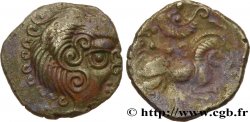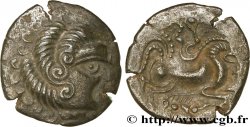v28_0618 - CORIOSOLITÆ (Area of Corseul, Cotes d'Armor) Statère de billon, classe V b, hybride vénèto-coriosolite
MONNAIES 28 (2007)
Starting price : 220.00 €
Estimate : 380.00 €
Realised price : 355.00 €
Number of bids : 2
Maximum bid : 1 220.00 €
Starting price : 220.00 €
Estimate : 380.00 €
Realised price : 355.00 €
Number of bids : 2
Maximum bid : 1 220.00 €
Type : Statère de billon, classe V b, hybride vénèto-coriosolite
Date: c. 80-50 AC.
Mint name / Town : Saint-Brieuc (22)
Metal : billon
Diameter : 21,5 mm
Orientation dies : 5 h.
Weight : 6 g.
Rarity : R3
Coments on the condition:
Agréable monnaie, malgré une faiblesse de frappe au revers sur la tête du cheval. Très beau droit stylisé. Une patine sombre met en valeur les reliefs légèrement plus clairs. Un coup de burin au revers, avec des traces vertes d'oxyde de cuivre
Obverse
Obverse legend : ANÉPIGRAPHE.
Obverse description : Tête humaine à droite, chevelure en trois rouleaux, les cheveux divisés en grosses mèches en forme de S, le nez réaliste, pointé, l’œil ovale.
Reverse
Reverse legend : ANÉPIGRAPHE.
Reverse description : Cheval androcéphale bridé, galopant à droite ; au-dessus, restes de la tête de l'aurige et hampe pointée ; entre les jambes, une lyre ; devant la bouche, une croisette.
Commentary
Ce statère appartient bien au monnayage coriosolite, mais son aspect fait plutôt penser au monnayage des Vénètes, de même que son type de droit qui se rapproche très exactement (et étrangement ?) de la classe VI des Vénètes. Ce phénomène confirme la contemporanéité de la classe V des Coriosolites avec la classe VI des Vénètes. Au revers, on peut observer une frise sous la ligne d’exergue perlée.








 Report a mistake
Report a mistake Print the page
Print the page Share my selection
Share my selection Ask a question
Ask a question Consign / sell
Consign / sell
 Full data
Full data









